I’m lucky enough to own a physical Tweed Deluxe amp. I also think that a Tweed Deluxe amp rig for home use has become so expensive in 2023, it’s difficult to justify. So I’ve started looking at alternatives, to see how they compare to the real thing.
I’ve previously looked at UAD’s Fender 55 Tweed Deluxe plugin (which did well). How will Fractal Audio’s Deluxe Tweed model in my Axe-FX 3 compare?
Table of Contents
- tl;dr
- What Is The Deluxe Tweed Model?
- What Do I Need To Use It?
- My Rig Today
- An Important Caveat
- How Does It Sound?
- Tweaking The Fractal Amp Block
- Getting Even Closer To My Amp
- How Does It Sound After All The Tweaking?
- How Does The Price Compare?
- One Last Benefit: I Can Take My Sound With Me
- Final Thoughts
tl;dr
With some simple tweaking, I got the Fractal Audio Axe-FX 3 mk 2 to both sound and feel like my actual 5e3 Tweed Deluxe amp’s rhythm tone. I am blown away by that. I’ve got my sound without having to lug my amp + attenuator around (the preset I built works in the portable FM-3 unit too).
The Axe-FX 3 mk 2 is around £1,000 cheaper than a real Tweed Deluxe amp + attenuator setup at the time of writing. However, if you don’t already have something suitable, you’ll end up spending those savings on decent studio monitors so that you can hear the Axe-FX 3. And if you want to gig it, you’ll need to spend extra money on a standalone poweramp + FRFR speaker cab.
I’m happy to recommend the Axe-FX 3 if you’re looking for the sound of a 5e3 Tweed Deluxe, with the one caveat that I found it a lot easier to get a sound that I was happy with because I could A/B it against my real amp.
I’m sure that the out-of-the-box sound is an accurate recreation of the Tweed Deluxe that Fractal Audio have. It just wasn’t the sound that I’m used to, and it didn’t feel the same to play though. Thankfully, it was easy to tweak to sort that out, because of how powerful the Axe-FX 3 firmware is.
What Is The Deluxe Tweed Model?
The Deluxe Tweed is an amp model inside the Axe-FX 3, FM-9 and FM-3 digital modelling products.
According to Fractal Audio’s wiki, it’s modelling a 1957 5e3 Deluxe Reverb through the INST channel. That’s perfect: it’s exactly how I’m using my real Tweed Deluxe amp with my Telecaster.
The Axe-FX 3 also includes a separate model where both channels are jumpered. I’ll look at that in a future blog post 🙂
What Do I Need To Use It?
You need one of Fractal Audio’s digital modelling products:
- the Axe-FX 3
- the FM-9
- or the FM-3
I believe the current Deluxe Tweed model was introduced in firmware 16.00 for the Axe-FX 3, as part of the switch to the new Cygnus modelling. In older firmware, the Deluxe Tweed model only emulated a 5e3 Deluxe with the channels jumpered.
At the time of writing, the latest firmware is 22.01 for the Axe-FX 3, and 7.00 for the FM-3.
My Rig Today
My signal chain is:
- Squier 50s Esquire with Seymour Duncan Antiquity bridge pickup (aka The Squirrel)
- into Input 1 on my Axe-FX 3
- through the Deluxe Tweed model
- out of Output 1 on my Axe-FX 3
- into Inputs 3 & 4 on my Universal Audio Apollo
- into the EP-34 tape delay plugin
- into the Precision Reflection Engine plugin (setup for spring reverb)
and into my DAW.
The Axe-FX 3 is running my own preset for this. I’ve set several scenes up for each of the audio examples in this blog post.
For the real amp, my signal chain is:
- same Squier 50s Esquire guitar
- into the INST 1 input on my Fender 57 Custom Deluxe amp
- speaker out into my Fryette PS-100 Power Station
- out of the XLR line out
- into Input 2 on my Axe-FX 3
- into Inputs 3 & 4 on my Universal Audio Apollo
- into the EP-34 tape delay plugin
- into the Precision Reflection Engine plugin (setup for spring reverb)
and into my DAW.
My aim here is to focus entirely on how the amp model compares to my 5e3 Tweed Deluxe amp, by keeping everything else the same across both signal chains.
An Important Caveat
A digital model of a 5e3 Tweed Deluxe is going to sound like a Tweed Deluxe. It’s never going to sound exactly like my Tweed Deluxe.
(This rule of thumb applies to any model of any type of amp, not just my specific amp!)
Why is this the case?
- Valve amps are analogue tech. Each of the electronic components is made to a certain tolerance; it’s not exact in the way that digital products are. And there’s no guarantee that the components were correctly QA’d for their values in the first place.
- The electrical properties of these components changes over time (commonly referred to as ‘drift’). A new amp made to spec isn’t going to sound the same as an old amp made to the same spec.
- I’m recording my amp through an attenuator. While it’s a very good one, no attenuator is 100% sonically transparent.
All I can do in this comparison is form an opinion on whether or not I can get a convincing 5e3 Tweed Deluxe sound out of my Axe-FX 3.
As you’ll hear in a bit, thanks to how tweakable the Axe-FX 3 tones are, I managed to do a bit better than that 🙂
How Does It Sound?
When I’m using my Tweed Deluxe amp with my Telecaster, I just set it up for the classic rhythm drive sound and leave it there:
- Telecaster plugged into Instrument 1 input
- Instrument Volume at 4
- Mic Volume at 8
I’ve left the Tone control at around noon for this, because this is a pretty bright Telecaster.
So I’ve gone for an equivalent setup in the Axe-FX 3. This is what the amp block looks like in this present & scene:
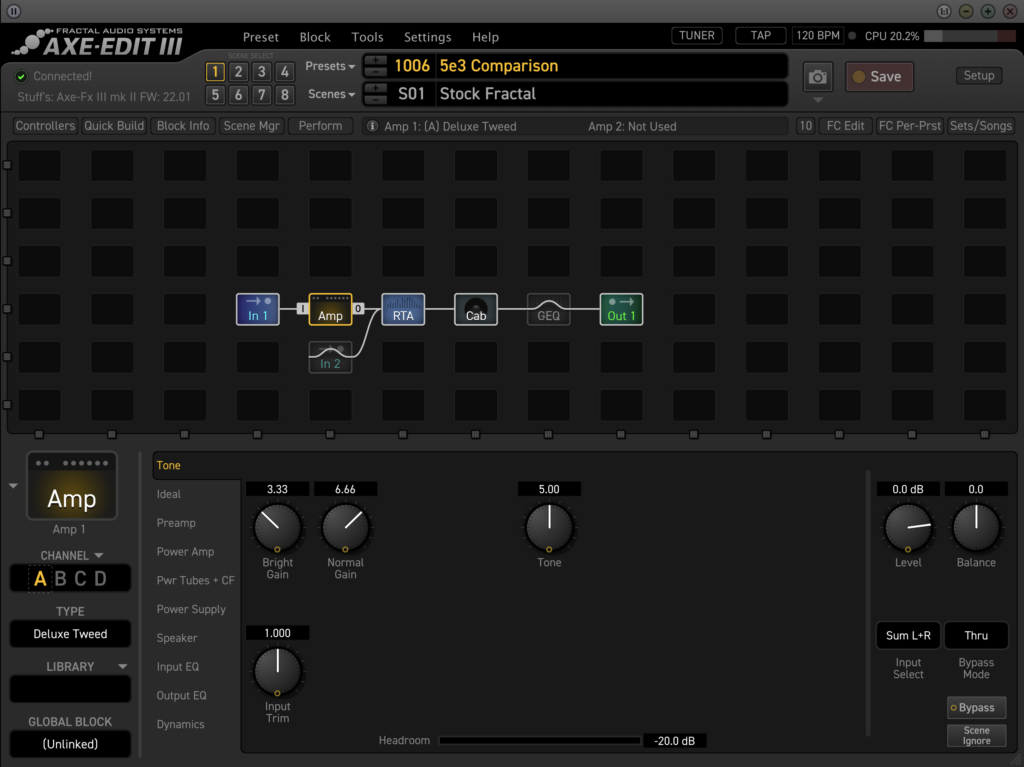
For the cabs, I’m using the new Dyna-Cab feature, with a Dynamic 1 and a Ribbon mic, both panned dead centre:
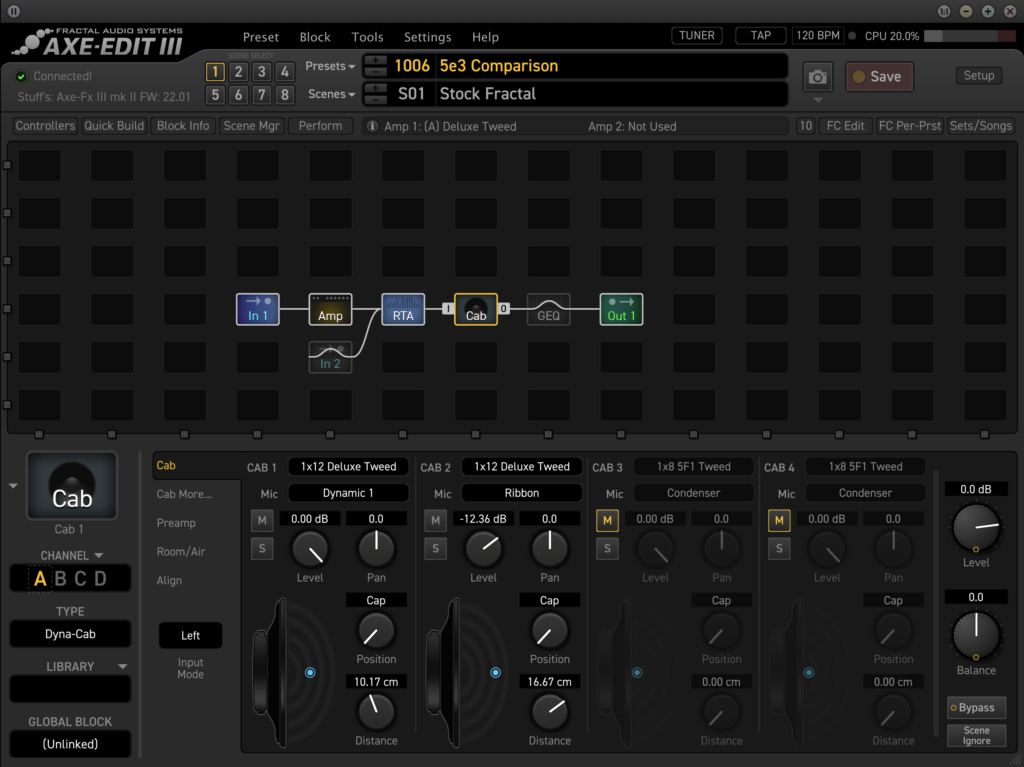
This is pretty similar (but not identical) to the mic setup in the UAD Fender 55 Tweed Deluxe plugin. I can’t get it exactly the same, as the Axe-FX 3 Dyna-Cabs currently do not include off-axis virtual mics.
And this is what it sounds like:
For comparison, here’s my real Tweed Deluxe amp, setup the same way:
And, for good measure, I’m going to throw in the demo I made using the UAD Fender 55 Tweed Deluxe plugin:
I’m hearing a lot of 5e3 tweed-tone goodness in the Fractal Audio model. In particular, the note attack and that distinctive paper-buzzing raspiness is there, along with the mid-range focus that (imho) is distinctive to the 5e3 Tweed Deluxe.
But …
When I was recording the demo, the Fractal Audio model sounded quite different to me (compared to my amp). It also felt pretty different to play though.
The two main things I hear are:
- there’s a lot of boxiness in the Fractal Audio model – more apparent through my studio monitors than through consumer-level earbuds
- the Fractal Audio model has a lot less gain than my amp – and also less than the UAD plugin at the same settings
There’s also a few other differences I noticed when playing, which might not come through on the recording:
- the Fractal Audio model has a lot less compression than my amp does
- the low-end strings are collapsing / farting out more than my amp does, even though the model has a lot less gain at the same settings
Would I use the Fractal Audio model straight out of the box? Personally, no, because my opinion is coloured by my experience with my amp. Someone else with experience of a different amp might well, though. It clearly sounds like a 5e3 Tweed Deluxe; it just doesn’t sound like my Tweed Deluxe (yet).
However, one of the great things about the Axe-FX 3 is just how many tools Fractal Audio gives us to tweak the tone.
Let’s get to work!
Tweaking The Fractal Amp Block
Cleaning Up The Mud
I have a common problem with my Axe-FX 3 and perceived low-end mud around the 250 hz frequency. Thankfully, it’s easy to dial out. There’s a couple of ways to do it. Normally, I’d use the Amp block’s Output EQ to do this (to save on CPU). This time round, I’m going to use a separate Graphic EQ block, so that I can reuse the EQ that I applied to my real amp:
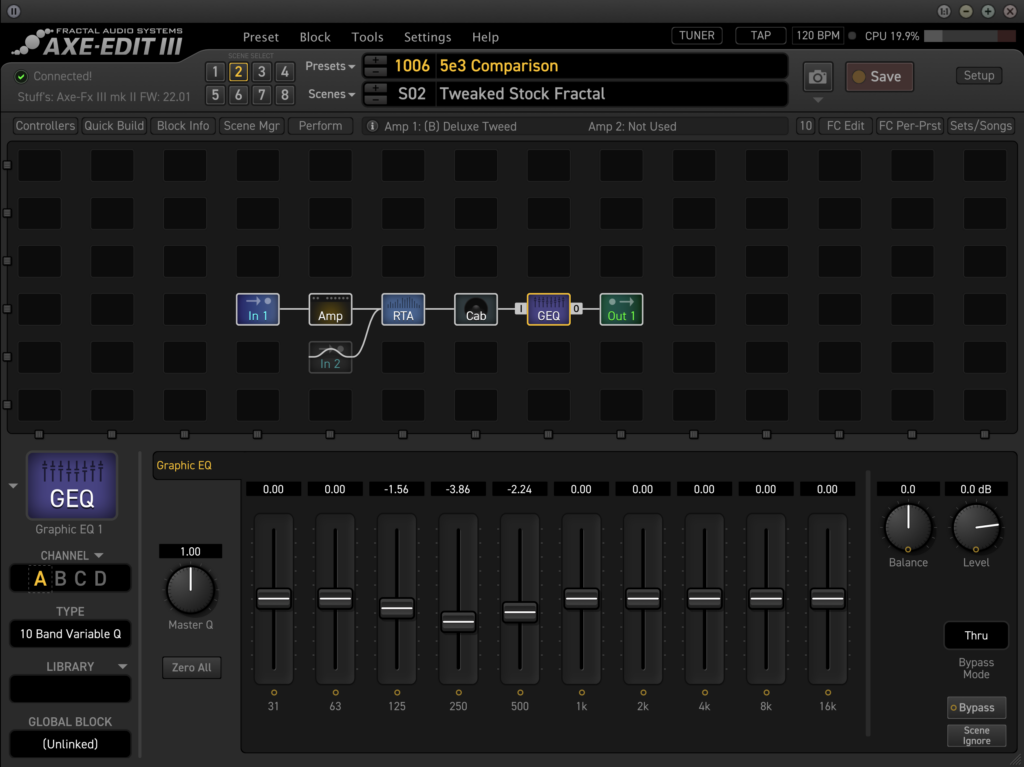
I think it speaks well to the accuracy of the amp model that I can take EQ applied to my real amp and use it on the model too.
Improving Low-End Clarity
To stop the low-end strings collapsing so much, I experimented with another EQ before the amp (amongst other things). In the end, a small tweak to the Amp block’s Input EQ seemed to do the job even better:

Other EQ Tweaks To Dial It Right In
I also wanted to tweak the mid-range emphasis of the amp model a bit:
- pull back the bass and mids a bit
- add a little more clarity on the top end
- add a little high cut to keep the attack nice and rounded and tweed-like
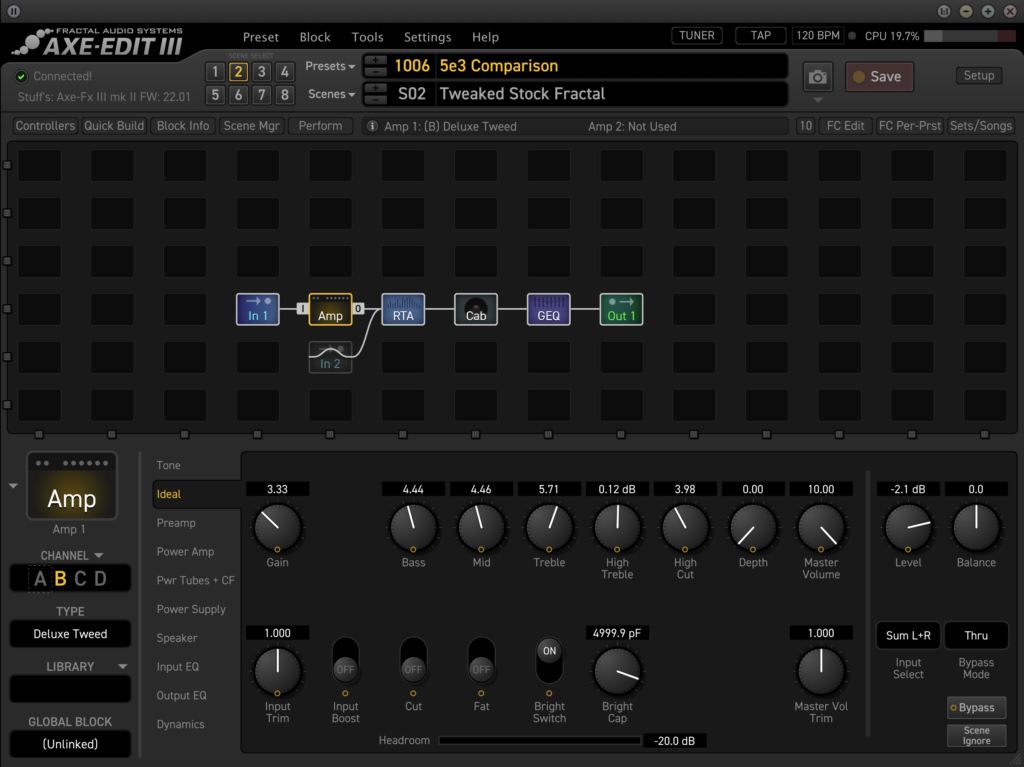
Balancing The Low End By Tweaking The Speaker Emulation
All the changes above really thinned out the amp’s low end, and took away a lot of the foundational low-mids that I love in a recorded tweed tone.
This is where Fractal Audio’s recently-added Dyna-Cab feature comes to the rescue. It allows me to move that virtual ribbon mic closer to the speaker, so that the proximity effect can kick in to bring back those low-mids without becoming boxy again:
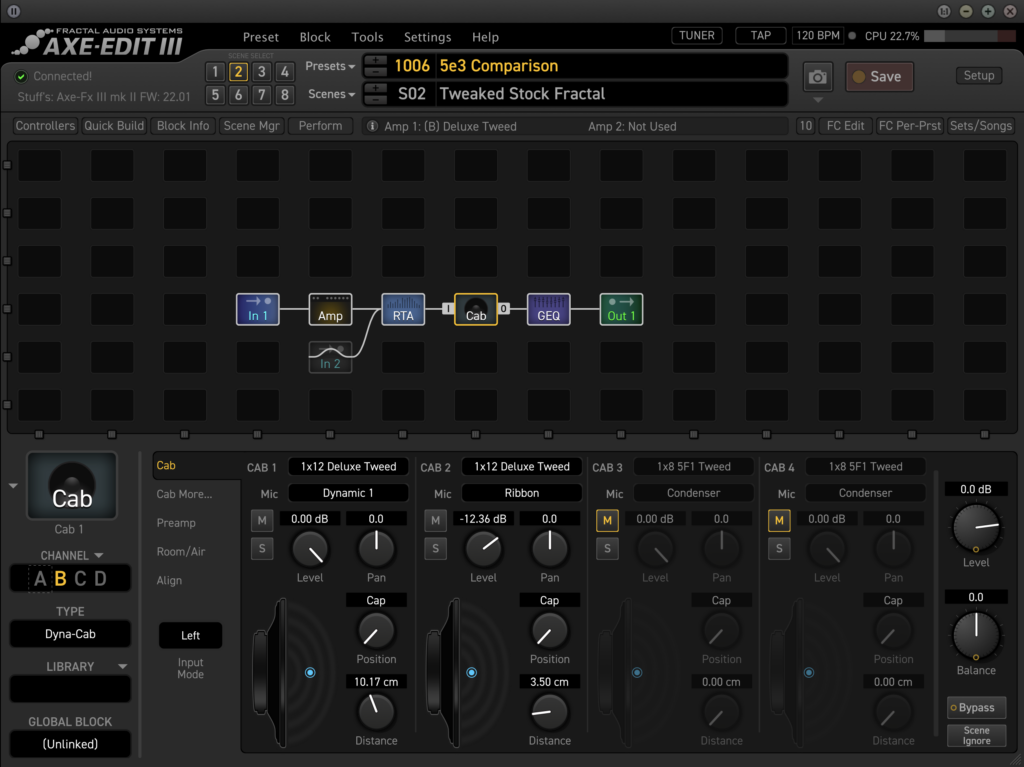
That was a little boomy on its own. I fixed that by adding a low cut to the Ribbon mic, exactly like how the Universal Audio Fender 55 Tweed Deluxe plugin does in its stock settings:
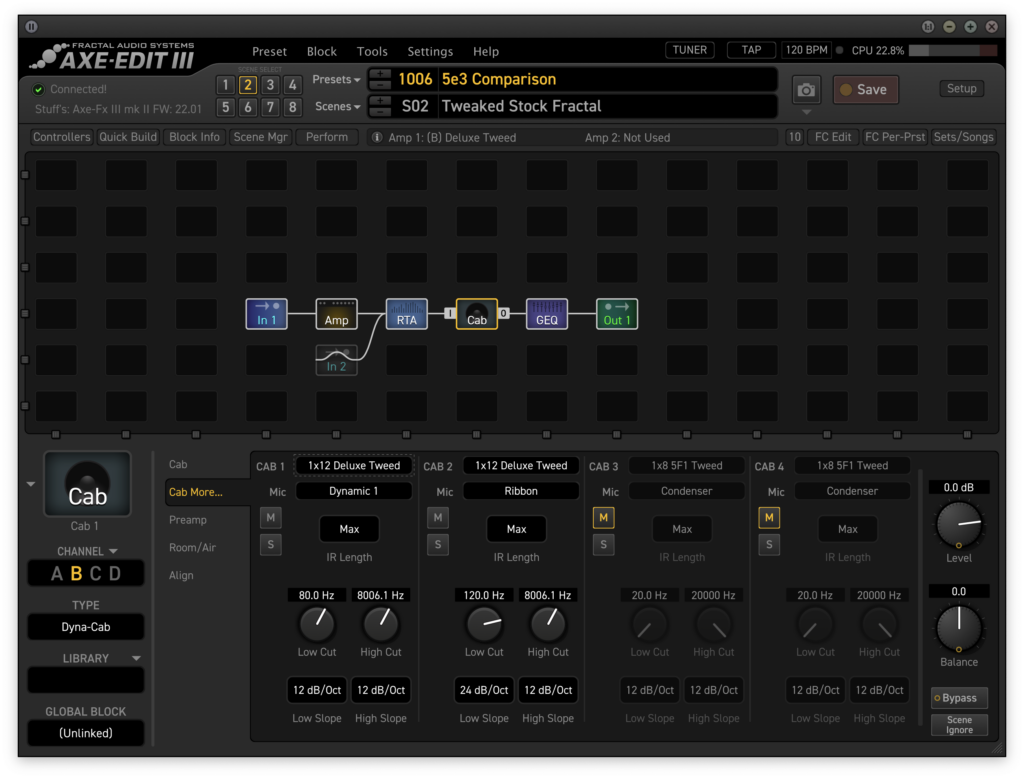
How Does That Sound Now?
After all those tweaks (and a lot of back and forth until I’d stopped tweaking!), this is what I got:
Again, for comparison, here’s my real Tweed Deluxe amp:
To my ears, the tone is much closer after making those tweaks.
When I listen to them back to back, I’m immediately drawn now to the difference in gain / saturation between the two, rather than any glaring differences in EQ. I can still hear a difference in the mid-range, but it isn’t enough to make me go back and tweak some more.
But I’m not done yet.
Getting Even Closer To My Amp
I’m of the opinion that my Fender 57 Custom Deluxe is a bit of an outlier. It seems to break up much earlier than other Tweed Deluxe amps that I’ve seen and heard in demos, and it sounds more saturated to my ears too. Whether my amp’s behaviour is authentic / accurate or not, it’s a characteristic that I’ve come to really enjoy.
The Fractal Audio firmware gives me the tools to try and get the same characteristics from the Deluxe Tweed amp model.
To get more gain, I have to abandon the classic ‘4-8’ volume settings in the model. With some trial and error, I settled on boosting the ‘Bright Gain’ to get closer to the amount of gain in my own amp:
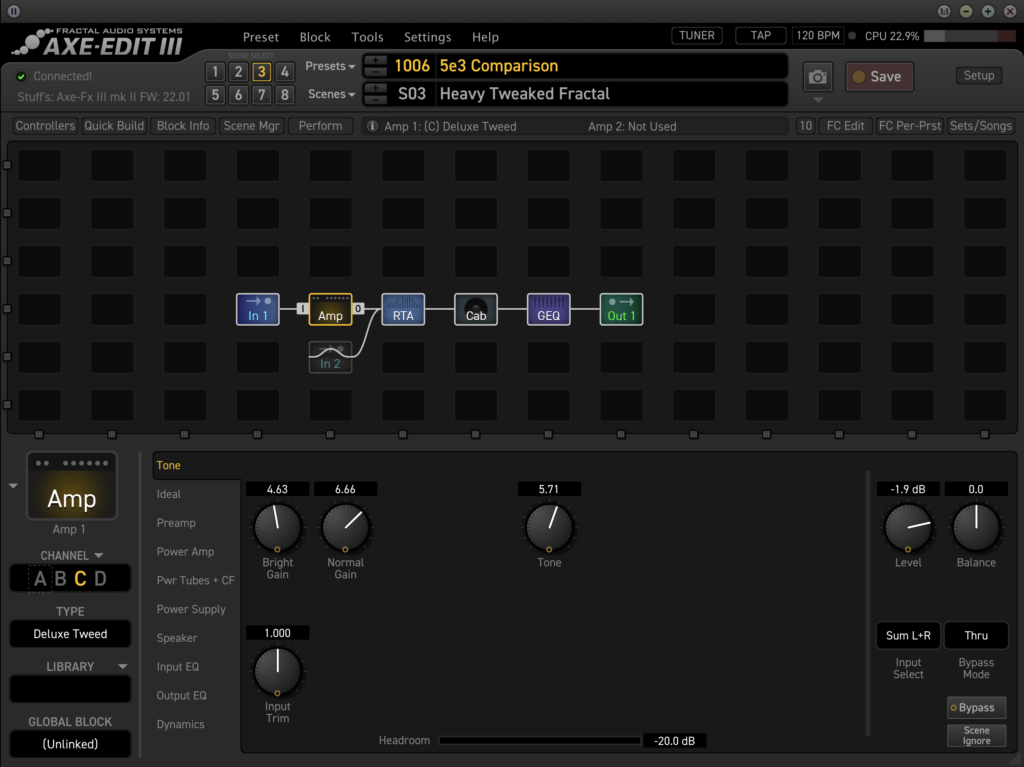
I also wanted to get closer to the feel of my own amp. I achieved that by going into the Dynamics section of the Amp block and adding some output compression to the signal:
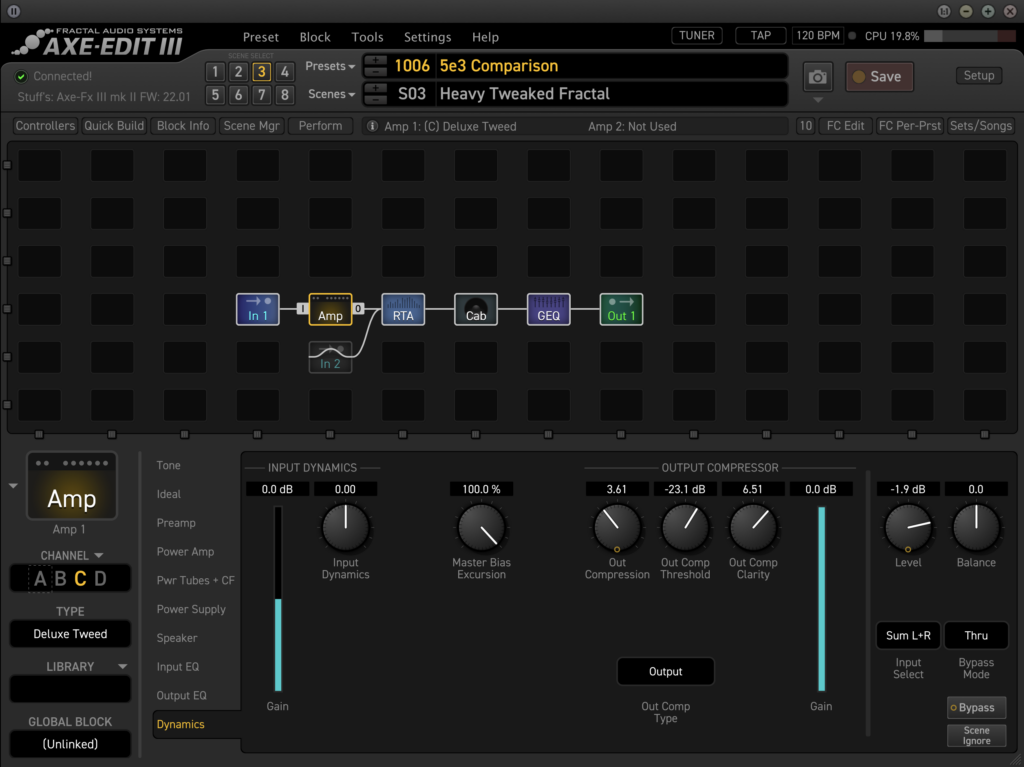
That’s all I had to do. I didn’t have to change other settings anywhere to compensate for these changes.
How Does It Sound After All The Tweaking?
Here’s my final result from the Axe-FX 3’s Deluxe Tweed amp model:
Once again, for reference, here’s the sound of my real Tweed Deluxe amp:
That sounds very very close to me.
There’s some differences in the low-end, which I think is entirely down to the mic distance on the virtual ribbon mic. I’m confident I could get that to match with fresh ears and more time.
I’m also hearing a little more saturation from my real amp. Is the difference a bad thing? I suspect not. I’m mostly a rhythm player, and less saturation in the amp model will probably give me better note separation.
Most importantly, both the model and the real amp feel very similar to play through now. No matter which one I use, I’ll produce very similar performances. That’s essential for me. It means that I can use my preset without worrying that I should be using the real amp instead.
How Does The Price Compare?
How does the cost of the Axe-FX 3 compare to a real Tweed Deluxe amp + attenuator?
At the time of writing, a brand-new Axe-FX 3 mk 2 is about £2,540. That’s about £1,000 less than a brand-new Fender Tweed Deluxe amp + attenuator.
For that, you not only get a unit that can sound just like a real Tweed Deluxe amp, but you also get a world-class fx processing unit, an audio interface, and something like 300 other amp models to explore. Plus the Axe-FX 3 brings the convenience of digital recall / reproducibility. Oh, and I don’t have to be paranoid about blowing up the transformer whenever I power it on. (I’m always worried about forgetting to plug the amp into the attenuator before powering it on.)
To hear the Axe-FX 3, you’re going to need either a good set of studio monitors, or an external poweramp + FRFR cab setup. That will eat into a good chunk of the savings, and could well end up costing even more than the Tweed Deluxe amp + attenuator setup. Arguably, you need the studio monitors for any recording studio setup – even a home hobbyist one – so that’s something you may already have. Just be aware that you might need to spend money on upgrading your setup if you currently have budget / small studio monitors at home.
One Last Benefit: I Can Take My Sound With Me
My amp + its attenuator isn’t a very portable rig. It’s big, it’s heavy. And I’d be worried about how hard it is to get the amp repaired if it got damaged while travelling.
Now, granted, I’m not going to take my Axe-FX 3 with me either. It’s wired into my little home studio rack, and I don’t fancy undoing all of that whenever I want to take my sound with me.
But I also have Fractal Audio’s FM-3 for gigging with, and it’s small enough to fit into a regular-sized tote bag. I can easily find space for that whenever I’m travelling, and take the sound of my Tweed Deluxe with me whenever I want.
And I can take most of my other sounds with me too at the same time.
Final Thoughts
To be honest, this result has been a huge (and very welcome) surprise.
Back during lockdown, when I was researching options for my first Tweed Deluxe amp, I came across this thread on the Fractal Audio forums which left me feeling like Fractal had no interest in modelling this particular amp accurately. (Thankfully, that changed during the preparation of firmware 16.00, which happened after I’d ordered my amp.)
At the time, it played a big part in me going for a real amp instead of getting an Axe-FX 3. With hindsight, I’m grateful that it did.
Can the Axe-FX 3 do the 5e3 Tweed Deluxe thing? Yes. Hell yes. In a mix, I doubt that I could tell you which was the amp model and which was my real amp. And the ability to make tiny tweaks to the amp model gives it a versatility that’s very un-tweed like, in a good way 🙂
Would I have gotten there without a real Tweed Deluxe amp of my own to constantly A/B my preset with? I very much doubt it.
That’s the one caveat I have with recommending the Axe-FX 3 as an alternative to the real amp, specifically for us inexperienced home tone enthusiasts. Maybe it’s just me, but I constantly find that I get the best results out of the Axe-FX 3 whenever I’m using it to recreate amp tones that I’m already experienced in.
Without that prior experience, I wouldn’t be anywhere near as happy with the Deluxe Tweed model in the Axe-FX 3 as I am.
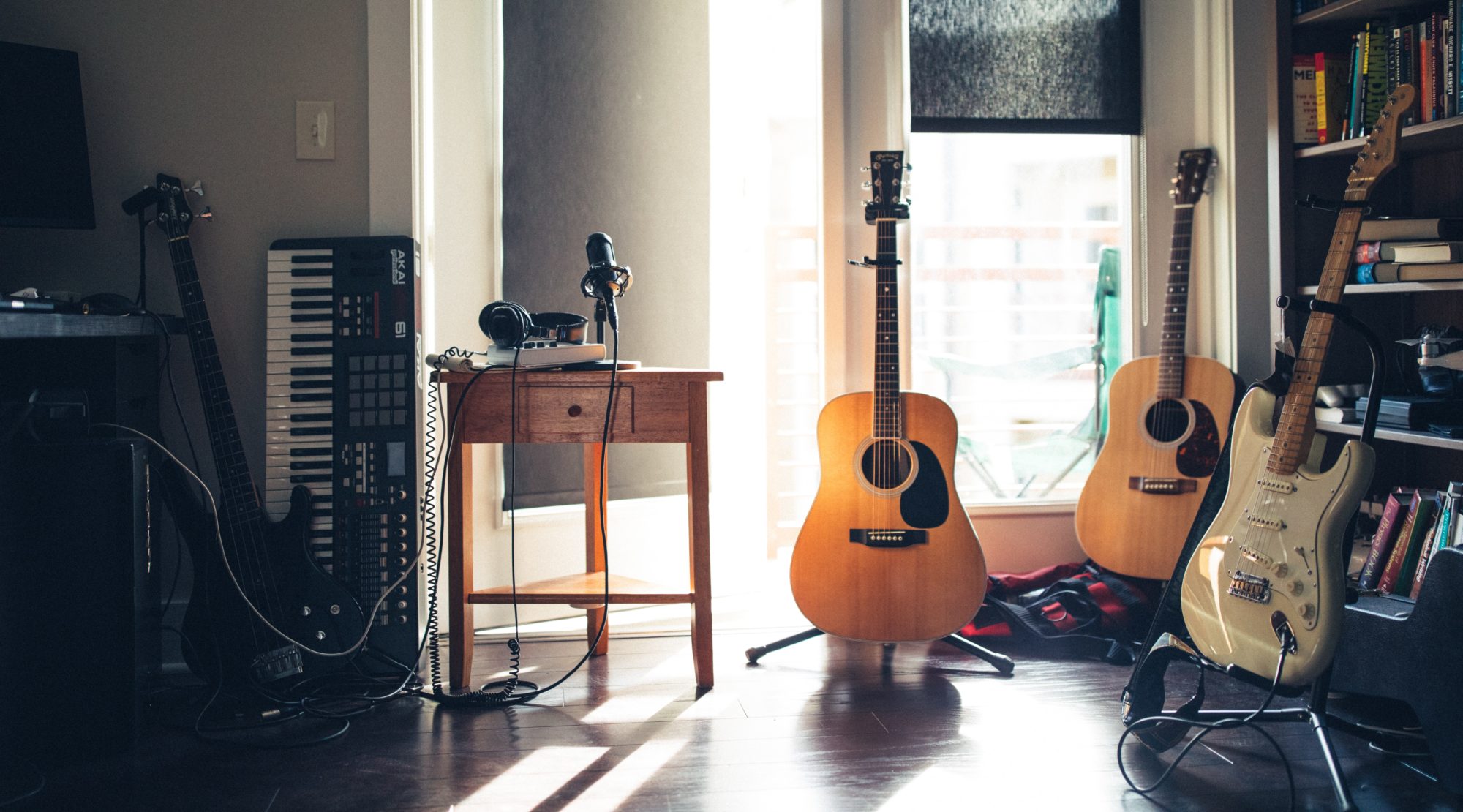
One Reply to “#TweedTone: Comparing Fractal Audio’s Deluxe Tweed Model With A Physical Tweed Deluxe Amp”